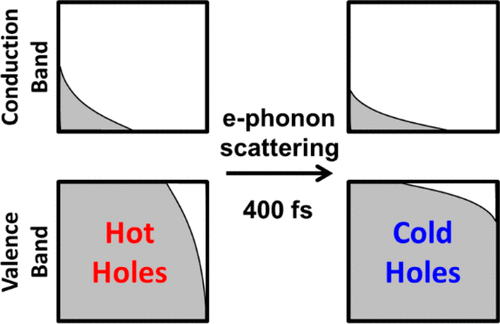当前位置:
X-MOL 学术
›
J. Am. Chem. Soc.
›
论文详情
Our official English website, www.x-mol.net, welcomes your
feedback! (Note: you will need to create a separate account there.)
Carrier-Specific Hot Phonon Bottleneck in CH3NH3PbI3 Revealed by Femtosecond XUV Absorption
Journal of the American Chemical Society ( IF 14.4 ) Pub Date : 2021-11-23 , DOI: 10.1021/jacs.1c07817 Max Verkamp 1 , Joshua Leveillee 2 , Aastha Sharma 1 , Ming-Fu Lin 3 , André Schleife 2, 4, 5 , Josh Vura-Weis 1
Journal of the American Chemical Society ( IF 14.4 ) Pub Date : 2021-11-23 , DOI: 10.1021/jacs.1c07817 Max Verkamp 1 , Joshua Leveillee 2 , Aastha Sharma 1 , Ming-Fu Lin 3 , André Schleife 2, 4, 5 , Josh Vura-Weis 1
Affiliation

|
Femtosecond carrier cooling in the organohalide perovskite semiconductor CH3NH3PbI3 is measured using extreme ultraviolet (XUV) and optical transient absorption spectroscopy. XUV absorption between 44 and 58 eV measures transitions from the I 4d core to the valence and conduction bands and gives distinct signals for hole and electron dynamics. The core-to-valence-band signal directly maps the photoexcited hole distribution and provides a quantitative measurement of the hole temperature. The combination of XUV and optical probes reveals that upon excitation at 400 nm, the initial hole distribution is 3.5 times hotter than the electron distribution. At an initial carrier density of 1.4 × 1020 cm–3 both carriers are subject to a hot phonon bottleneck, but at 4.2 × 1019 cm–3 the holes cool to less than 1000 K within 400 fs. This result places significant constraints on the use of organohalide perovskites in hot-carrier photovoltaics.
中文翻译:

飞秒 XUV 吸收揭示 CH3NH3PbI3 中特定载体的热声子瓶颈
使用极紫外 (XUV) 和光学瞬态吸收光谱法测量有机卤化物钙钛矿半导体 CH 3 NH 3 PbI 3中的飞秒载流子冷却。44 和 58 eV 之间的 XUV 吸收测量从 I 4d 核心到价带和导带的跃迁,并为空穴和电子动力学提供不同的信号。核到价带信号直接映射光激发空穴分布并提供空穴温度的定量测量。XUV 和光学探针的组合表明,在 400 nm 激发时,初始空穴分布比电子分布热 3.5 倍。初始载流子密度为 1.4 × 10 20 cm –3两个载流子都受到热声子瓶颈的影响,但在 4.2 × 10 19 cm –3 时,孔在 400 fs 内冷却到小于 1000 K。这一结果对有机卤化物钙钛矿在热载流子光伏中的使用产生了重大限制。
更新日期:2021-12-08
中文翻译:

飞秒 XUV 吸收揭示 CH3NH3PbI3 中特定载体的热声子瓶颈
使用极紫外 (XUV) 和光学瞬态吸收光谱法测量有机卤化物钙钛矿半导体 CH 3 NH 3 PbI 3中的飞秒载流子冷却。44 和 58 eV 之间的 XUV 吸收测量从 I 4d 核心到价带和导带的跃迁,并为空穴和电子动力学提供不同的信号。核到价带信号直接映射光激发空穴分布并提供空穴温度的定量测量。XUV 和光学探针的组合表明,在 400 nm 激发时,初始空穴分布比电子分布热 3.5 倍。初始载流子密度为 1.4 × 10 20 cm –3两个载流子都受到热声子瓶颈的影响,但在 4.2 × 10 19 cm –3 时,孔在 400 fs 内冷却到小于 1000 K。这一结果对有机卤化物钙钛矿在热载流子光伏中的使用产生了重大限制。











































 京公网安备 11010802027423号
京公网安备 11010802027423号